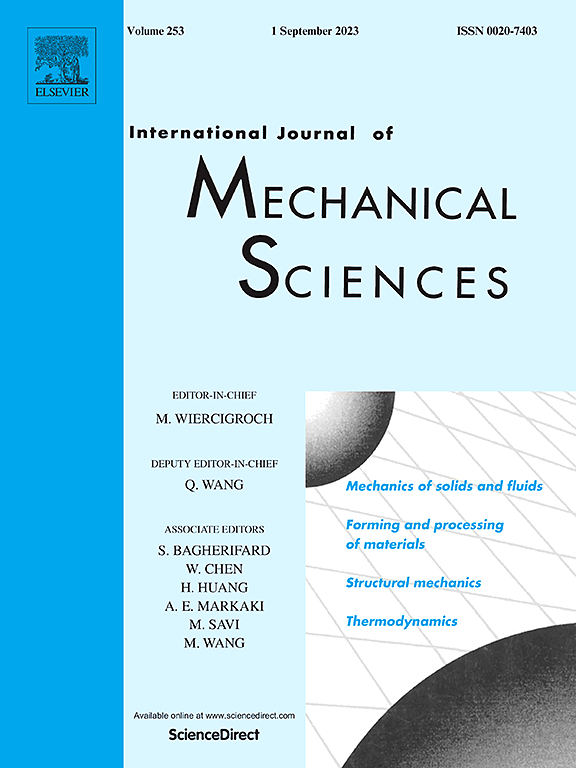Machine Learning Accelerates Programmable Mechanics in Isotropic Diamond Plate Lattices
IF 7.1
1区 工程技术
Q1 ENGINEERING, MECHANICAL
International Journal of Mechanical Sciences
Pub Date : 2025-07-11
DOI:10.1016/j.ijmecsci.2025.110595
引用次数: 0
Abstract
This study presents a cascaded, integrated machine-learning framework for the rapid design and optimization of fully isotropic, diamond-inspired composite plate-lattice metamaterials (DMSCs), extendable to any composite architecture. An artificial neural network (ANN) trained on finite-element simulation data quickly screens large design spaces for isotropy, achieving a roughly 105-fold speed-up in candidate identification compared to conventional methods. The ANN-driven screening identifies 483 perfectly isotropic configurations, which are then used to train a Bayesian-optimized XGBoost regression surrogate to accurately predict three static mechanical metrics. Coupling these surrogates with the Non-Dominated Sorting Genetic Algorithm II (NSGA-II) yields 209 Pareto-optimal plate-lattice designs that balance stiffness, plateau stress, and energy absorption. The top design (unit-cell width: 11.3 mm; wall thickness: 1.19 mm; scaling factor α = 0.77) was validated by high-fidelity finite-element simulations, with all predicted metrics deviating by less than 4%. Our analysis reveals that the composition scaling factor α influences mechanical performance over three times more than relative density, overturning the traditional density-centric design paradigm. Additionally, our method extends the viable fully isotropic relative density range by approximately 17%, providing a robust foundation for developing ultralight, high-strength metamaterials for demanding aerospace and defense applications.
机器学习加速各向同性金刚石板晶格的可编程力学
本研究提出了一个级联、集成的机器学习框架,用于快速设计和优化全各向同性、钻石启发的复合板-晶格超材料(DMSCs),可扩展到任何复合结构。在有限元模拟数据上训练的人工神经网络(ANN)可以快速筛选大的各向同性设计空间,与传统方法相比,候选识别的速度提高了大约105倍。人工神经网络驱动的筛选确定了483种完美的各向同性配置,然后用于训练贝叶斯优化的XGBoost回归代理,以准确预测三个静态力学指标。将这些替代算法与非支配排序遗传算法II (NSGA-II)相结合,得到209个平衡刚度、平台应力和能量吸收的帕累托最优板-晶格设计。顶部设计(单胞宽度:11.3 mm;壁厚:1.19 mm;比例因子α = 0.77)通过高保真有限元模拟验证,所有预测指标偏差小于4%。我们的分析表明,成分比例因子α对机械性能的影响是相对密度的三倍以上,颠覆了传统的以密度为中心的设计范式。此外,我们的方法将可行的全各向同性相对密度范围扩展了约17%,为开发用于苛刻的航空航天和国防应用的超轻、高强度超材料提供了坚实的基础。
本文章由计算机程序翻译,如有差异,请以英文原文为准。
求助全文
约1分钟内获得全文
求助全文
来源期刊

International Journal of Mechanical Sciences
工程技术-工程:机械
CiteScore
12.80
自引率
17.80%
发文量
769
审稿时长
19 days
期刊介绍:
The International Journal of Mechanical Sciences (IJMS) serves as a global platform for the publication and dissemination of original research that contributes to a deeper scientific understanding of the fundamental disciplines within mechanical, civil, and material engineering.
The primary focus of IJMS is to showcase innovative and ground-breaking work that utilizes analytical and computational modeling techniques, such as Finite Element Method (FEM), Boundary Element Method (BEM), and mesh-free methods, among others. These modeling methods are applied to diverse fields including rigid-body mechanics (e.g., dynamics, vibration, stability), structural mechanics, metal forming, advanced materials (e.g., metals, composites, cellular, smart) behavior and applications, impact mechanics, strain localization, and other nonlinear effects (e.g., large deflections, plasticity, fracture).
Additionally, IJMS covers the realms of fluid mechanics (both external and internal flows), tribology, thermodynamics, and materials processing. These subjects collectively form the core of the journal's content.
In summary, IJMS provides a prestigious platform for researchers to present their original contributions, shedding light on analytical and computational modeling methods in various areas of mechanical engineering, as well as exploring the behavior and application of advanced materials, fluid mechanics, thermodynamics, and materials processing.
 求助内容:
求助内容: 应助结果提醒方式:
应助结果提醒方式:


